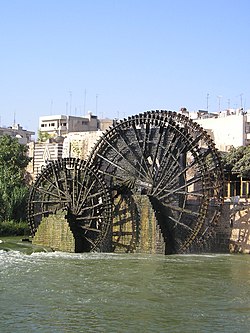Norias of Hama
35°8′7″N 36°45′11″E / 35.13528°N 36.75306°E

The Norias of Hama (Arabic: نواعير حماة) are a number of norias ("wheels of pots") along the Orontes River in the city of Hama, Syria. Only seventeen of the original norias remain. They are mostly unused now and serve an aesthetic purpose. They were called "the most splendid norias ever constructed."[1] The norias of Hama were submitted as a tentative World Heritage Site by the Syrian Arab Republic in June 1999.[2]
History

The earliest evidence for norias in Hama suggests they were developed during the Byzantine era, although none of the norias in Hama today precede the Ayyubid period. However, a mosaic found at Apamea dating to 469 AD pictures a noria very similar to those at Hama, suggesting they may have earlier origins.[3] Now only 17 norias remain, unused.[4] On August 11, 2014, it was reported on Twitter that they had been burned down by drunken soldiers.[5][better source needed]
Description
This section is empty. You can help by adding to it. (October 2014) |
References
- ^ Needham and Ronan, 1995, p.281.
- ^ http://whc.unesco.org/en/tentativelists/1291
- ^ Adriana De Miranda (2007). Water Architecture in the Lands of Syria: The Water-wheels. L'ERMA di BRETSCHNEIDER. pp. 53–. ISBN 978-88-8265-433-7. Retrieved 24 August 2012.
- ^ Ring, Berney, Salkin, La Boda, Watson, and Schellinger, 1996, p.137-138.
- ^ Sindebad69 (9 August 2014). #ناعورة #حماة (in Arabic (comments)). Twitter. Retrieved 11 August 2014.
{{cite web}}: Unknown parameter|trans_title=ignored (|trans-title=suggested) (help)CS1 maint: numeric names: authors list (link) CS1 maint: unrecognized language (link)
Bibliography
- Ring, Trudy; Berney, K.A.; Salkin, Robert M.; La Boda, Sharon; Watson, Noelle; Schellinger, Paul (1996), International Dictionary of Historic Places: Middle East and Africa, Routledge, ISBN 1-884964-03-6.
- Needham, Joseph; Ronan, Colin A. (1995), The Shorter Science and Civilisation in China: Volume 5, Cambridge University Press, ISBN 0-521-46773-X.
